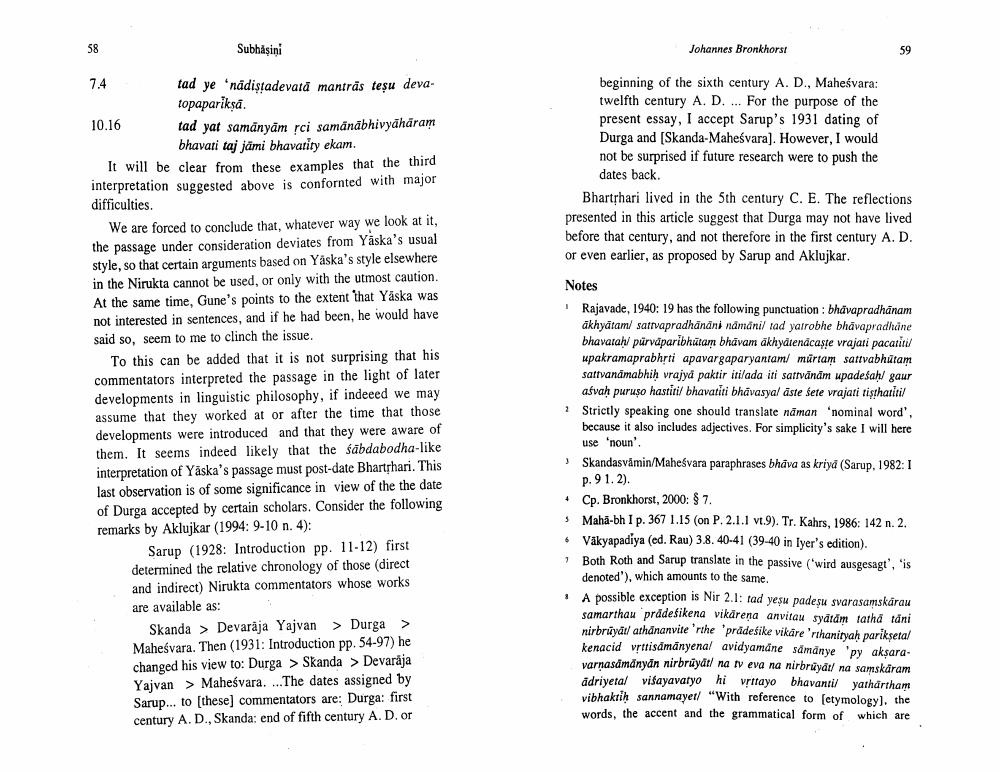Book Title: Yaska And Sentence Beginning Ofsabdabodha Author(s): Johannes Bronkhorst Publisher: Johannes Bronkhorst View full book textPage 8
________________ Subhăşini Johannes Bronkhorst beginning of the sixth century A. D., Maheśvara: twelfth century A. D. ... For the purpose of the present essay, I accept Sarup's 1931 dating of Durga and (Skanda-Maheśvara). However, I would not be surprised if future research were to push the dates back Bharthari lived in the 5th century C. E. The reflections presented in this article suggest that Durga may not have lived before that century, and not therefore in the first century A. D. or even earlier, as proposed by Sarup and Aklujkar. tad ye 'nadistadevatā mantras teșu deva topapariksa. 10.16 tad yat samāyām rci samänābhivyähäram bhavati taj jāmi bhavatity ekam. It will be clear from these examples that the third interpretation suggested above is confornted with major difficulties. We are forced to conclude that, whatever way we look at it, the passage under consideration deviates from Yaska's usual style, so that certain arguments based on Yaska's style elsewhere in the Nirukta cannot be used, or only with the utmost caution. At the same time, Gune's points to the extent that Yaska was not interested in sentences, and if he had been, he would have said so, seem to me to clinch the issue. To this can be added that it is not surprising that his commentators interpreted the passage in the light of later developments in linguistic philosophy, if indeeed we may assume that they worked at or after the time that those developments were introduced and that they were aware of them. It seems indeed likely that the sabdabodha-like interpretation of Yaska's passage must post-date Bhartrhari. This last observation is of some significance in view of the the date of Durga accepted by certain scholars. Consider the following remarks by Aklujkar (1994: 9-10 n. 4): Sarup (1928: Introduction pp. 11-12) first determined the relative chronology of those (direct and indirect) Nirukta commentators whose works are available as: Skanda > Devaraja Yajvan > Durga > Maheśvara. Then (1931: Introduction pp. 54-97) he changed his view to: Durga > Skanda > Devaraja Yajvan > Maheśvara. ...The dates assigned by Sarup... to [these] commentators are: Durga: first century A.D., Skanda: end of fifth century A. D. or Notes ! Rajavade, 1940: 19 has the following punctuation : bhdvapradhanam akhyatam/ satrvapradhānani námánil tad yarrobhe bhavapradhiine bhavarah/purvaparibhutam bhāvam ākhyatenacaste vrajati pacatiti/ upakramaprabhrti apavargaparyantam/ murtam sativabhitam sattvandmabhih vrajya paktir itilada iti sattvändm wpadesah/ gaur afvah puruso hastiti bhavatiti bhāvasyal aste sete vrajati tishatiti 1 Strictly speaking one should translate naman 'nominal word', because it also includes adjectives. For simplicity's sake I will here use 'noun'. Skandasvämin/Maheśvara paraphrases bhava as kriya (Sarup, 1982: 1 p. 91.2). + Co. Bronkhorst, 2000: $ 7. Maha-bh I p. 367 1.15 (on P. 2.1.1 vt.9). Tr. Kahrs, 1986: 142 n. 2. 6 Väkyapadiya (ed. Rau) 3.8. 40-41 (39-40 in Iyer's edition). 1 Both Roth and Sarup translate in the passive ( wird ausgesagt', 'is denoted'), which amounts to the same. • A possible exception is Nir 2.1: tad yesu padesu svarasamskarau samarthau pradeśikena vikārena anvitau syatam tatha tani nirbrüydt/ athananviterthe 'prādešike vikare 'rthanityah parikseta/ kenacid vrtfisámányenal avidyamane sdmanye 'py akşaravarnasámánydn nirbrüyatl na iv eva na nirbrüydt/ na samskram adriyeta/ visayavatyo hi vrttayo bhavanti/ yathartham vibhaktih sannamayetl "With reference to etymology), the words, the accent and the grammatical form of which arePage Navigation
1 ... 6 7 8 9 10
